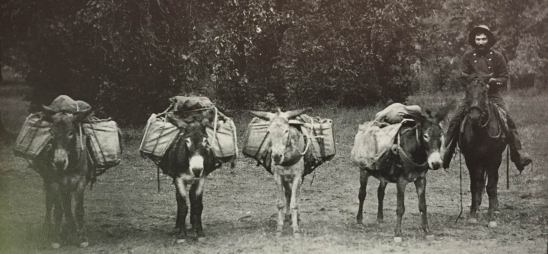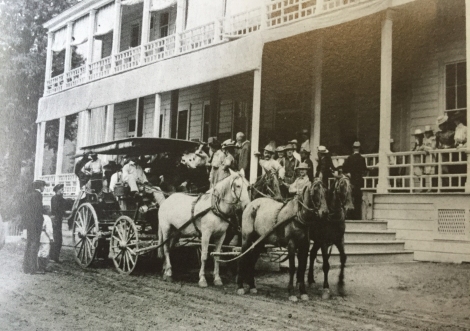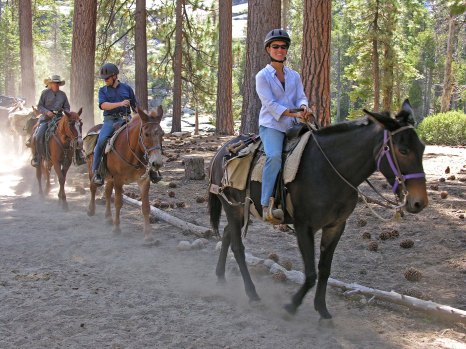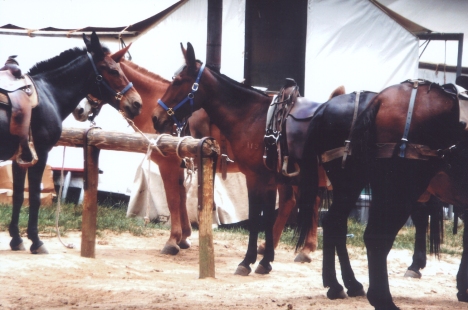
Mules have a long history in Yosemite National Park. In Yosemite’s early days, mules were responsible for getting people and supplies into the park and were crucial in early road building efforts in Yosemite, Sequoia, and Kings Canyon National Parks. In 1864, James Hutching brought in a pack train of 100 horses and mules, starting the tradition of tourist stables in Yosemite Valley. In the late 1800s, Wawona was developed and became the largest stage stop in Yosemite. Stagecoaches would often stop at Wawona Hotel for the night before the final eight-hour push to Yosemite Valley the next day.

With their reputation as sure-footed, reliable animals, mules have long reigned supreme to horses for packing and riding on Yosemite’s rocky terrain and steep trails. Compared to horses, they also endure heat better, eat less, more rarely have hoof problems, do better in groups, and tend to have a higher sense of self-preservation.
Mules are used in a variety of ways in the park today. On a trail ride from the stables in Yosemite Valley, Tuolumne, or Wawona, you’ll probably be assigned a mule instead of a horse. Mules are great animals for riders of all levels. Because mules stick with their horse mothers when they’re young, they naturally follow horses, the preferred animal for guides to ride. When you take a trail ride, you’ll see that the mules are quite good at following each other in a line.

Mules are responsible for getting all five of Yosemite’s High Sierra Camps running. Every part of each High Sierra Camp – the tent canvas and frames, wood stoves, mattresses, and more – was originally brought in by mules. Pack mule trains deliver food and supplies to each camp twice a week on a set schedule in the summer. If you’re hiking on trails near the high camps, you may cross paths with pack trains. If you do, say hello, step to the side of the trail, and wait for the mules to pass.

If you’re dying to ditch your heavy backpack or skip the hiking, consider a custom or standard saddle trip. Most trips allow you to spend a few days with a professional guide packer learning about Yosemite and traveling from one High Sierra Camp to another. Custom pack trips are available from all three of our stables. These trips book up far in advance, but you can call the stable at (209) 372-8348 and check for availability.
In Yosemite and other parks across the country, mules are essential tools for trail crews, wilderness rangers, backcountry utilities, fire suppression, and search and rescue efforts. To top it all off, mules are spunky, mohawked animals full of lovable personality.
This is the last year to take a trail ride at the stables in Tuolumne and Yosemite Valley, but there are no planned changes to trail rides at Wawona Stable. If you’d like to go on a trail ride, find more information online.
*Black and white photos are from Arcadia Publishing’s Images of America books about Yosemite Valley and Yosemite National Park and Vicinity.


How truly tragic. It breaks my heart to see such an amazing piece of Yosemite history taken out of the Valley. We’ve lost so much already, campgrounds, lodging, the Big Trees Tram Tour and now this. Before we know it, the Yosemite we all know and love will be nothing but a treasured memory.
LikeLike
I was at the Yosemite Valley stables one time during a small earthquake. The mules woke up and ambled out of the barn, but didn’t panic.
LikeLike
It seems they are planning it for the very well to do and making it less convenieent and affordable for seniors, the working and middle class.
LikeLike
Horseback riding is a special time with FAMILY. And the views are spectacular when you are on a horse/mule. I LOVE HORSES – beautiful animals! I can’t believe these rides will no longer be available in Yosemite Valley. (I really enjoyed this website and videos on the horses/mules and when they were out on the range. Very nicely done!)
LikeLike